History of Farming in the Český Krumlov Region
 I. Agriculture before
the year 1650:
I. Agriculture before
the year 1650:
Farming, its success and often a bad crop, represented the basic
problem of life for the majority of people in the past times. In
comparison to other regions, the estates of Český Krumlov came
under the heading of less yielding, even in the period, when the
climatic conditions were kinder to cereal farming, than in periods
which were much colder - for example the second half of the 16th
and the beginning of the 17th century. A more detailed picture of
the extent of agriculture, its yield, the amount of bread wheat
used and the trading with the commodity, can be gained only in
connection with remaining written documentation. This routine was
carried out from the middle of the 16th century by employees of
authority, for the reason of more accurate information of the
responsibilities of serfs and the possibility of purchasing wheat
for the estate's brewery, which belonged together with the fishing
industry to the most profitable and advanced business activity of
the Rosenberg farms. It is necessary to forget more accurate
information, prior to the year 1500 and partial results can be
brought, if we did not take into account icono-graphic material,
only by medieval archaeology. Even though the soil on the estates
of Český Krumlov was not ideal, the farming settlements and
nobility estates grew most of the days produce. Only from the
middle of the 16th century did the farmers start to orient
themselves to higher yield growing and sale of wheat to the
breweries, whilst from the lords' estates purchases were made for
rye, which was the basic bread ingredient (rye bread was marked as
"slightly bitter"). Wheat became a strategic ingredient for the
manufacture of malt, which was used for the manufacture of
so-called "white" beer. Barley, from which a better quality - also
more expensive - beer was made was more successful in the local
conditions than wheat. The majority of the crop area of the serfs
as well as the lords' estates, was taken by oats, which was
necessary for horse feed, that played the major part in transport
facilities. It was also normal to grow buckwheat (the farming of
this became wide spread during the 14th century in middle Europe,
and sometimes bread was made from it) millet, peas, flax and hemp.
Towards the end of the 15th century, in the towns and villages (in Český Krumlov behind the city walls) a number of fenced fruit gardens was growing. In the castle (and with some exceptions in town gardens) glass houses and orange groves were established, where the cultivation of different kinds of subtropical plants (different kinds of citrus fruit, lemons, oranges, figs and melons) took place. Around the town of Český Krumlov were hop fields and even not too yielding vineyards. The basic system of seeding technique remained the so called three-tiered field system, there was rotation of seeded produce on a field divided into three sections, where one always remained fallow for the purpose of revitalisation (so-called barren).
The key period of each agricultural year - harvest - brought an increased demand on labour force, and therefore it is not surprising, that hired labour was used, and in the interest of maintaining the social standing, the responsibility of the serfs to their authorities became a part of an unchanging written fixed legislation. Not every farmer or villager had the same experience of these types of feudal responsibilities. There were not many differences amongst the Český Krumlov estates, maybe in the size of the settlements (from the 16th century there were around 35,
the smallest magistrate looked after 50 people, some over 2,000 serfs) and villages (some of them had only 3 - 5 buildings, the biggest up to 25 buildings) but also in the amount of tithes, financial percentage and manorial labour. A quarter of the estates did not pay any wheat tithes. The manorial labour on the authorities' estates was not used in nearly a half of the settlements. But on the manor estates quite noticeable differences between the farmers from neighbouring estates existed (for example farmers from Střítež and Raven, Ktiš and Záhoří etc.). It was said, that the average farmer from Černá, did not have to pay his lord (if we forget the king's taxes) more than sixty groschen a year while a farmer from Boletice paid 17 times sixty and also had to work six days in the year on the manor estates. In spite of these "neighbourly differences" which could have caused fights and local conflicts, we cannot find in the region of Český Krumlov during this early modern era other wide spread rebellions. Its influence had "agrarian politics" which was advantageous to both sides, the farmers as well as the gentry up to the first half of the 17th century, which was based on commercial business with cereals as a key raw material for the lucrative brewery trade. In spite of the physically demanding agricultural work and the potential fear from an unsuccessful crop, which could in a very short time ruin a whole family, that it is difficult to imagine in the modern era of relative affluence, represents the period from the middle of the 16th century to year 1618, the so-called "golden era" of the South Bohemian farmers.
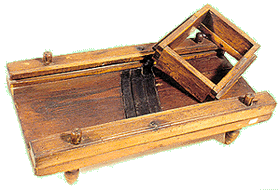
|
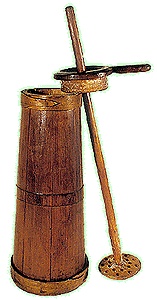
|
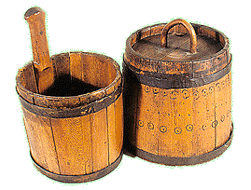
|
II. Farming from the middle of the 17th century to
1938:
The situation in villages in the region of today's Český Krumlov,
was very disconsolate after the end of the Thirty Years' War in
the middle of the 17th century. Especially touchy were the results
of the previous wars such as the plundering of villages. Many farms
remained burnt out and abandoned and their revival took several
years. Some fields were not cultivated because lack of labour
force. The revival of agriculture was due to the thanks of the
protected aristocratic families (the owners of estates and farms -
Český Krumlov, Rožmberk nad Vltavou, Vyšší Brod, and part of the
estate of Nové Hrady at Kaplice, and other smaller farms), who
provided from their granaries seed to their serfs, and from their
farms young animals, so as to make it easier for them to return to
farming and managing of their settlements. The return to normal in
the country was gradual during the whole second half of the 17th
century. For illustration we show the yield of cereals after year
1620, after the harvest only four, at best six corns from one
sown.
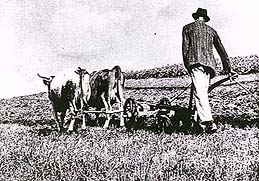
|
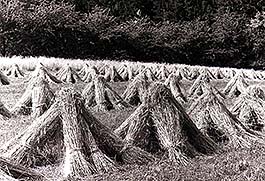
|
The farmsteads were the representatives of production within the running of the estates and manors. These units were sufficiently equipped with utility buildings (stables, barns, granaries, tiny flats for labour) and labour, it means permanent labour who looked after the animals and pigs throughout the whole year. The work in the fields of the manor, and harvest of cereals were usually taken care of by the serfs under their manorial labour.
In consolidated relations on the turn of the 17th and 18th century, settlement started to spread towards the border, and with this the farming of places, which in many cases used to be woods.
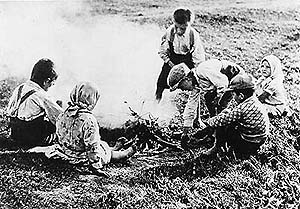 New settlers were given
under strictly agreed conditions land from the manor which they
could use at their own free will, they could build cottages, and
change the use of land from uncultivated to arable and grazing
fields.
New settlers were given
under strictly agreed conditions land from the manor which they
could use at their own free will, they could build cottages, and
change the use of land from uncultivated to arable and grazing
fields.
The living standard of people living in villages and also in towns, during the 18th century, was quite modest by today's opinion. They were not allowed to move into other regions, go to school, learn a trade, nor get married without the approval of the lord of the manor. Certain freedom was brought by the introduction of two reforms: In 1775 the patent of serfdom, which measured the working responsibilities of serfs depending on the wealth of the peasant and adjusted the length of working day. In 1781 came a patent which terminated the status of bondage.
From the beginning of the 19th century, the yield from grain was getting higher because of more consistent forms of farming, improved farm machinery and effective fertilising of the fields.
Other freedom to the people from unpleasant responsibilities was brought by the ending of serfdom, manorial labour and all feudal restrictions from 1848 and 1849. The farmers had to buy themselves out of the responsibilities ("thorough release"), this was a financial burden for them and it carried on long into the second half of the last century. During that time our farmers were hurt by land crises in several waves, which of course affected the farming production and its disposal of farm estates. Before the end of the 19th century and at the beginning of the 20th century, the economy in the manor farms was generally passive.
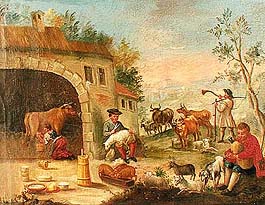
|
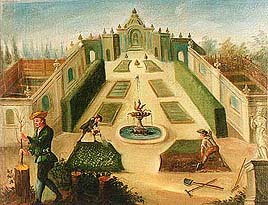
|
The first world war touched the natural development of Bohemian
farming, with all its negative effects. The Bohemian countryside
was suddenly without a male labour-force and without horses. There
was not sufficient grain for seeding, not enough natural and
artificial fertilisers. The number of cattle was reduced
dramatically, and farming machinery of all types was not available.
But soon after the war the situation started to improve. Technology
started to be introduced into farming more and more.
 The favourable conditions
in the farming society at the beginning of the 20th century did not
show in the improvement of the standard of living amongst the
farmers in such a way as was expected. The small farmers of Šumava
were especially burdened heavily by financial problems.
The favourable conditions
in the farming society at the beginning of the 20th century did not
show in the improvement of the standard of living amongst the
farmers in such a way as was expected. The small farmers of Šumava
were especially burdened heavily by financial problems.
Into the post-war development of the farming world came the land reform, which generally means the state involvement in the ownership of land, for the purpose of new alterations. The land reform was closely followed not only by small farmers but as well by the landless people, who expected from it an improvement to their situation, and also the affected landlords and other speculators, who wanted to gain the maximum for themselves. The legislation of the land reform was done in two ways: the first transferred the land possessions and the right of use in the hands of large land ownership into the hands of others, the other followed the stabilising of relations in the use of land by the small farmers, and arranging peace during the introduction of the reform. In the region of Český Krumlov, some of the manor farms like Český Krumlov, Rožmberk and Vyšší Brod , and also several of the smaller farms were affected by the reform.

The loss of the border region due to the Munich agreement from September 29, 1938, also deeply affected the agricultural sector in the border region. It did not take long and the Nazis started to implement war farming. There were given regulations for compulsory supply of vegetable and animal products to the general market, the manufacture was regulated, prices were set. Gradually the labour was withdrawn from the fields and put into the manufacture process of mainly war materials. The results of the farming industry showed during occupation a visible reduction in the field of vegetable as well as animal production. The only production that increased was the production of oil type plants and plants grown for fibre, their production was also aiming especially for the war use.
Further information:
History
of Farming in Český Krumlov



